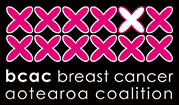Important research released 21 June shows huge disparities in breast cancer screening, treatment and outcomes for Māori and Pasifika women in New Zealand.
The Breast Cancer Aotearoa Coalition (BCAC) says this is unacceptable and is calling for significant immediate steps to be taken to improve this situation.
The research, How to Improve Outcomes for Women with Breast Cancer in New Zealand, was funded by the Health Research Council through the University of Waikato with assistance from Waikato District Health Board. It was led by Professor Ross Lawrenson.
The extensive three-year study analysed data from Auckland and Waikato breast cancer registers to determine what could improve survival rates. In New Zealand we have the ninth highest breast cancer rates in the world and the seventh highest mortality rates.
The study looked at data for more than 12,000 women in Auckland and Waikato, reflecting the wider New Zealand population.
The disparity for Māori and Pasifika women in breast cancer screening, treatment and outcomes really stood out in the research.
Survival rate
The latest study shows Māori women diagnosed with breast cancer are 76% more likely to die from the disease after five years than New Zealand European women, and Pasifika women twice as likely to die after five years than New Zealand European women.
Diagnosis and screening
The research highlights the need for more proactive screening and treatment across New Zealand, including programmes targeted to the needs of particular population groups.
Breast cancer tends to occur at a younger age in Māori and Pasifika women but diagnosis is often late. Screening of more Māori and Pasifika women, and beginning screening at a younger age, is recommended as a first strategy to help close the inequity gaps. BCAC believes publicly-funded screening should begin for all women at 40, rather than at the current age of 45, and Māori and Pasifika women should be the highest priority for this.
Targeted initiatives, national and regional hui and expert focus groups with Māori and Pasifika communities to develop strategies encouraging more women to participate in the BreastScreen Aotearoa screening programme, will help significantly to reduce inequities in breast cancer outcomes in New Zealand. The research shows that Māori women have similar outcomes to non- Māori women when their breast cancers are detected by screening, rather than waiting until symptoms appear.
BCAC Committee Member, Irene Kereama-Royal, says “We need Iwi and Pasifika leaders, heads of communities, elders and youth to engage with their communities, encouraging everyone to participate in finding solutions for their women of all ages.”
Exemplary leadership was shown by the late Talei Morrison in her #smearyourmea campaign. She encouraged Māori women to have cervical screening at all kapa haka events and the campaign spread widely through iwi connections, through social media and supported by the Māori King’s whānau, the Māori Women’s Welfare League and by kapa haka proponents.
Irene also cites the successful example of a programme on the East Cape of New Zealand run by Te Whānau ā Apanui Community Health Service where breast screening rates went from 45% to 98%.
The researchers explained that one of the biggest obstacles to getting more women to screening was the lack of access to a list of all eligible women. Concerns about privacy at the time New Zealand breast screening was set up prevent the programme from having access to the National Health Index (NHI) which has identity information on about 95% of New Zealand citizens. The more recent colorectal cancer screening programme does have access to these data.
“Allowing BreastScreen Aotearoa access to the NHI database would be a huge help in identifying eligible women and encouraging them to attend,” says BCAC Chair, Libby Burgess.
Hormone receptor positive cancer and endocrine therapy
For women with hormone receptor positive breast cancer it is important to continue endocrine therapy. The research found that at five years:
- Only 60% of European women were still taking their therapy
- Only 55% of Māori women were still taking their therapy.
BCAC believes that we need to put supports in place to ensure women understand the benefits and continue their endocrine therapy. This treatment reduces mortality by a third after five years and even more in the years beyond that.
HER2 positive breast cancer
The research confirmed the benefit of giving Herceptin treatment for HER2 positive breast cancer. New Zealand women who received it had 42% better survival than those who did not, showing that ‘real world data’ confirm what clinical trials have shown.
More Pasifika women in particular are diagnosed with HER2 positive breast cancer and at a younger age, when cancers tend to be more aggressive. However, fewer Māori and Pasifika women received Herceptin treatment.
“It is absolutely fundamental these groups are assisted to access and actively encouraged to take Herceptin. We need to put support in place to ensure women understand the benefits and take part in the treatment they require,” says Libby Burgess.
Advanced breast cancer
More Māori and Pasifika women have advanced breast cancer at time of diagnosis.
They tend to be from lower socio-economic backgrounds with lower access to health care.
Overall there were no differences between urban and rural women. However, rural Māori women’s outcomes were worse than urban Māori women’s outcomes. Rural Māori women with breast cancer tended to be older, more likely to be diagnosed with metastatic disease and less likely to be screen detected than urban Māori.
Again this emphasises the need for programmes tailored for specific population groups, delivered locally.
Public versus private health care
The research findings show that women who have treatment in the public system face much worse outcomes than those treated in the private health care system - with a 95% higher average risk of death. This is extremely alarming and needs to be addressed urgently.
“It is fundamental that women have earlier detection and faster access to the most effective treatments. We are struggling to achieve this in the public health system and clearly need more resources allocated,” says Libby Burgess.
Solutions
BCAC suggests the following solutions to reduce the inequities identified in the research:
- Increasing health literacy including women’s understanding of the need to take part in breast cancer screening and to continue with their treatment
- Introducing breast cancer screening programmes targeted to population subgroups, such as Māori and Pasifika
- Introducing screening at age 40 to increase the likelihood of Māori and Pasifika women’s cancers being detected earlier
- Enabling contact with women via their NHI number to enrol them in the national breast screening programme
- Increasing breast cancer funding in the public health system and ensuring the public system welcomes women of all cultures equally and appropriately.
RadioNZ interview:
Listen to BCAC's Irene Kereama-Royal and Libby Burgess discuss this issue on RadioNZ's Morning Report programme, 25 June.
Media release:
Read the media release announcing the key research findings, from The University of Waikato.
Reference:
Thompson, RM, Crengle, S, Lawrenson, R. 2009. Improving participation in breast screening in a rural general practice with a predominantly Maori population. New Zealand Medical Journal, 122, 39-47.
25 June 2018



